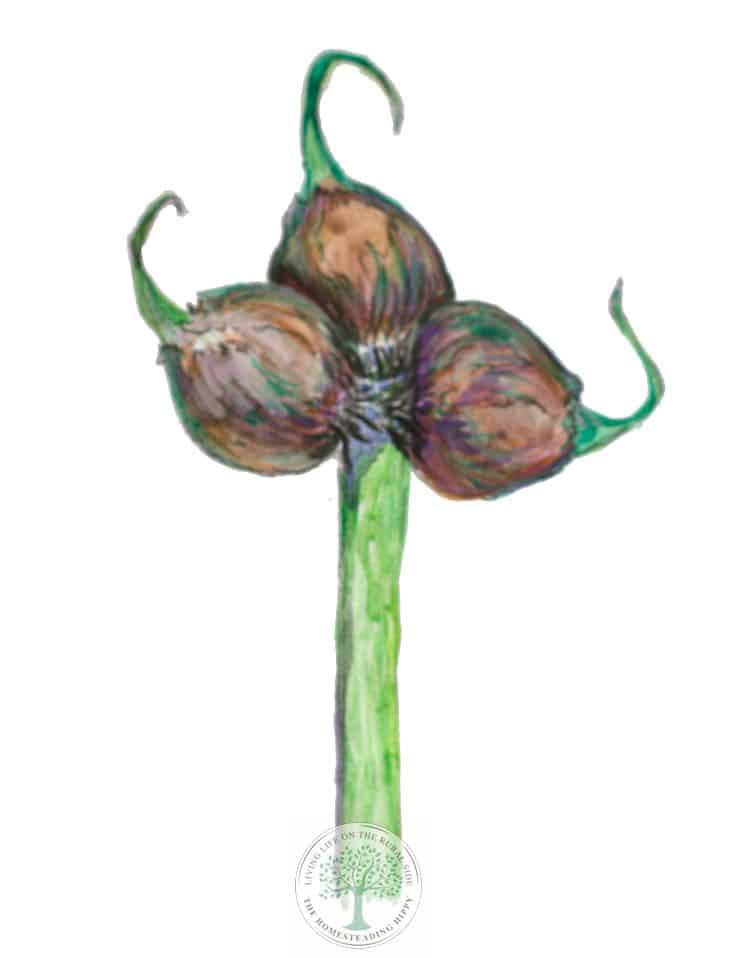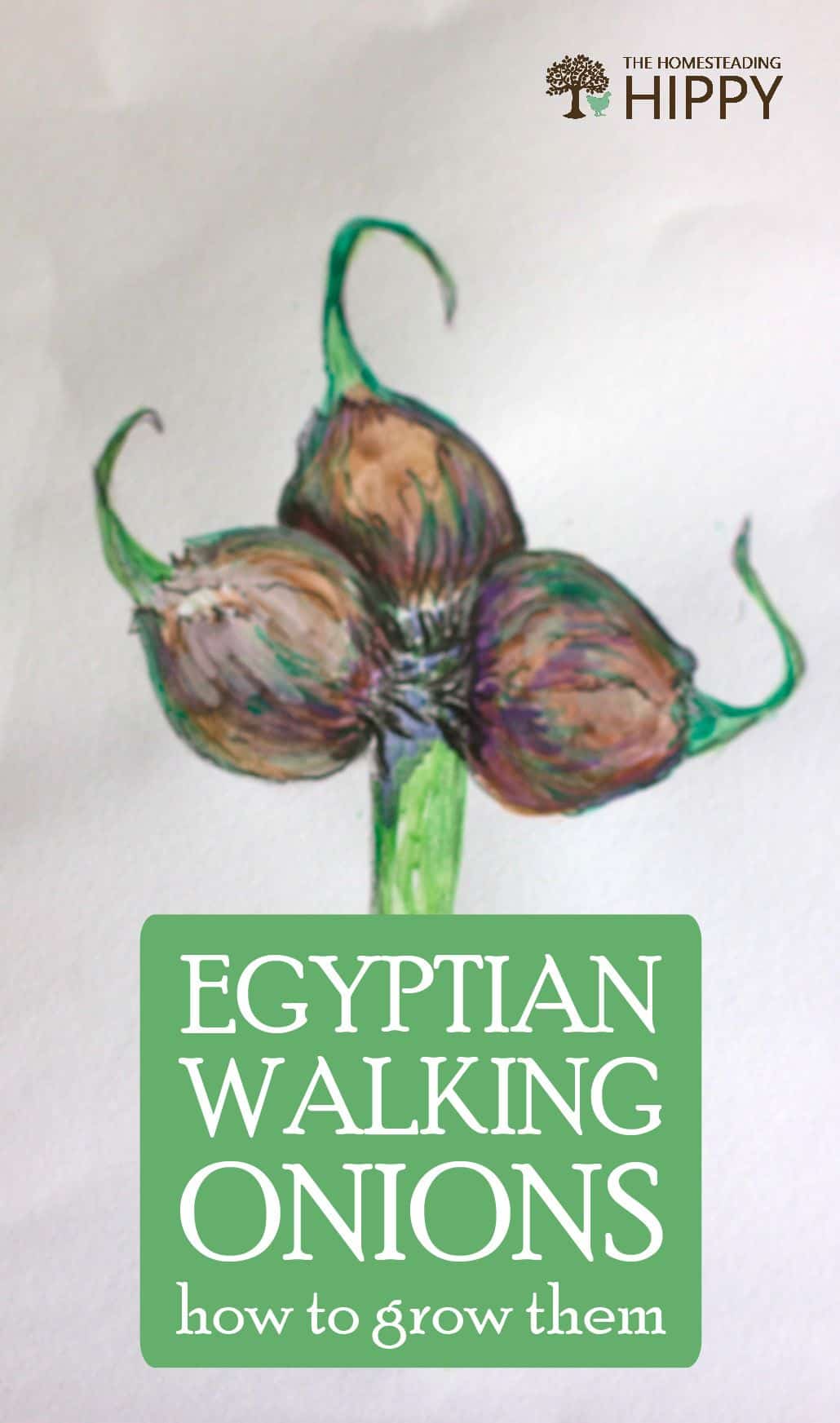Egyptian walking onions were possibly in your grandparents’ gardens, but over time they were forgotten. Nowadays, this very useful and easy plant is making a comeback, and reclaiming its rightful place in our gardens.
The name is certainly a strange one – and the plant even stranger. Most of us are used to onions with bulbs that are underground. Not these onions…

Other names for them include topsetting onions, tree onion, winter onions, perennial onions, and their botanical name, Allium x proliferum.
The first two names perhaps better describe the fact that you harvest the bulbils from the top of the plant and, as their botanical name implies, they certainly are prolific. They are also pretty tough – they’re among the first to appear after winter.
Each little bulbil produced at the top of the plant can be harvested to add to meals and salads, and some saved for later planting (if you chose to dig up the plant and use the bulb at the bottom).
The younger leaf stalks can also be eaten like chives, but the bulb under the ground can be a bit strong and tough if it’s an old one not harvested for a couple of years.
Origins
Egyptian walking onions get their name from the fact that, when the bulbils on the top of the plant become heavy, they bend over to touch the soil, and basically plant themselves as each little bulbil already has some rudimentary roots.
Over the years, the plant ‘walks’, so you should always have new top set onions, planting themselves in your garden. The average ‘walk’ for a plant over a year is 24 inches (61cm), and seeing as they are a perennial they will walk far over the years if you let them.
They are not invasive and fairly easy to control – so if you have a food forest let them walk away. If you have a smaller lot you may contain them and plant the new bulbils where you have decided they should grow.
As for the word Egyptian, these walking onions don’t seem to have anything to do with Egypt, in fact their origin in the wild is not known.
What is known, due to more recent genetic testing, is that the walking onion originated from a cross between the Welsh onion (Allium fistulosum), and the common onion (Allium cepa).
However, we do know that the onion was sacred to the Egyptians, as the layers upon layers inside the onion symbolized eternity.
Taste
The bulbils harvested from the top of the onion stalk taste a bit stronger than shallots, also known as eschalots, but are milder than white onions.
The base has a stronger flavor, and if it’s been in the ground for a couple of years can be a bit tough. If harvested straight after setting the bulbils, the base will be tasty to eat.
Using Them in Meals
Use anywhere you would use onions – chopped up on pizza, added to stews, soups, casseroles and stir-fries. The bulbils can be thinly sliced into salads and can also be used as you would pearl onions for pickling.

Where to Get the Bulbs
The plants seldom set seed as they produce only a few flowers among the top bulbils and mostly the seed is not viable. You can order bulbs to plant from here.
You can either order the bulbs from the base of the plant (which should grow fairy quickly), or order the bulbils from the top sets of the onions, which could take a bit longer. Either way, within 18 months you’ll have topsetting onions to add to your food supplies.
When to Plant
Don’t plant in spring if you are planting from the top sets, otherwise you will wait a longer time – until the next year.
Plant in summer so the plant can establish itself before the first frosts, mature through the winter, and be ready to reward your efforts with plenty of bulbils next summer.
If, however, you are planting from the base bulbs, you can do it in the spring. These onions do well in USDA zones 3 to 9. They are quite hardy, and your established plants will probably be one of the first poking up new shoots in early spring.
Planting Tree Onion Plants
Plant the small bulbils just over an inch (3 centimeters) deep, and space them out between
6 to 8 inches (15 to 20 centimeters) apart.
If you have a permaculture food forest, plant a couple of clumps in various areas where they get full sun, while maintaining the planting depth and spacing. Don’t attempt to grow these onions in shade – they will not be happy.
Prepare the soil in spring by adding mulch and compost, ready for the planting later in summer.
Some people advise not to dig in manure because the nitrogen content could affect the preservation of the onions after harvest, while others says to add cattle, horse or sheep manure.
Chicken manure is high in nitrogen content, so it’s probably best if you are going to add manure, to stay away from chicken manure.
Choose the fattest bulbils to plant as they have more food stored for growth and will produce vigorous plants.
Once the bulbs are planted, they will send up green shoots but the stronger stalk that will produce the bulbils may only pop up in the second season of growth.
The longer stalks will reach about 3 to 4 feet (that’s around 1 meter) in length , and the tiny bulbils will be enclosed in a white papery sheath that will split and fall off as the bulbils unfurl and develop.
Some will already have tiny leaves sprouting which gives them the appearance of little Medusa heads, while others will simply have a little green sprout at the top, and some roots at the base where they fasten to the shoot.
Soil and Water Requirements
Like the rest of the allium family Egyptian walking onions like full sun and a loamy well drained soil. They will not do well in heavy soils that retain moisture.
The pH of the soil should range between 6.2 and 6.8. If you don’t know the pH of your soil, this handy tester will help you determine the pH as well as two other factors – the soil moisture and light in the area. These readings will certainly help when planning your Egyptian walking onion plantings.
If the pH reading indicates an acid soil, then lime can be added as this will make it easier for the plants to absorb nutrients.
Add the lime before planting, and then again two to three times during the year to maintain the pH at the optimum level. You can use your pH meter to check when levels may be dipping.
As far as watering goes, walking onions are a survival gardener’s dream – they only require a bit of watering now and again – if the rain isn’t doing the job often enough.
Do not soak them often with a heavy watering – a light watering is all these easy onions need to keep performing year in and year out, once they are established. Most gardeners agree that they do best if left alone.
Permaculturist Mark Shephard (of New Forest Farm) believes in the STUN (sheer, total, utter neglect) principle and, it’s certainly doing well for the various crops on his farm.
His belief is that the plants know what they are doing, and if you just leave them be they will naturally become hardier and produce well.
Harvesting
The onions are small – between ¼ to one inch, and you would typically get about 6 to 8 bulbils from each plant, plus the bulb at the base should you decide to dig it up rather than allow it to grow as a perennial.
If you are going to dig up the onions, wait until the bulbils have formed and are ready to harvest before digging up the base bulb. If it is left in the ground, the plant will produce more bulbs – after a couple of years you’ll get 30 or more base bulbs.
Dividing Clumps
It’s a good idea to divide clumps every few years otherwise the top sets may be smaller and produce more flowers than bulbils as the plant realizes the clump is too large for the bulbils to reach open ground to plant themselves.
Unfortunately, the six-petalled white flowers don’t seem to produce viable seed, so not dividing plants will result in a reduced harvest.
Make sure some bulbils are kept in a dry dark place for planting later, and make sure they are undamaged with no signs of fungus before storing them. Store below 59 degrees Fahrenheit (15 degrees Centigrade) to make sure that black mold doesn’t develop.
Diseases
Egyptian walking onions are tough so are unlikely to be attacked by pests. However, the most likely fungal disease for onions of all types is Black Mold – Asperaillus niger.
The fungus results in black spots of mold appearing under the paper outer layers of onion skin. Although present in the soil it primarily affects onions after harvest if they have been damaged, or are wet when transported or stored.
In warmer areas, top set onions may be affected by Fusarium damping-off (Fusarium oxysporum). It’s important to not overwater as the fungus is in the soil, and thrives on dampness.
If you’re encouraging beneficial insects into your garden, you’ll have the balance right where the predatory insects will keep others under control, and by not over-watering, fungal diseases like black mold will be rare.


As a child I wanted to grow up and marry a farmer… simply because it was so different from my life right on the shores of the ocean. Well, I didn’t marry a farmer but a surfer instead. The urge, however, to grow stuff and make great food for a big family never left. We are on acreage with a sea view and easy access to fresh caught crayfish and other seafood – the best of both worlds. As an artist and writer I enjoy creating new recipes, tweaking traditional ones, and sharing the results not only with family and friends, but online. Mee the rest of the team at this page.
